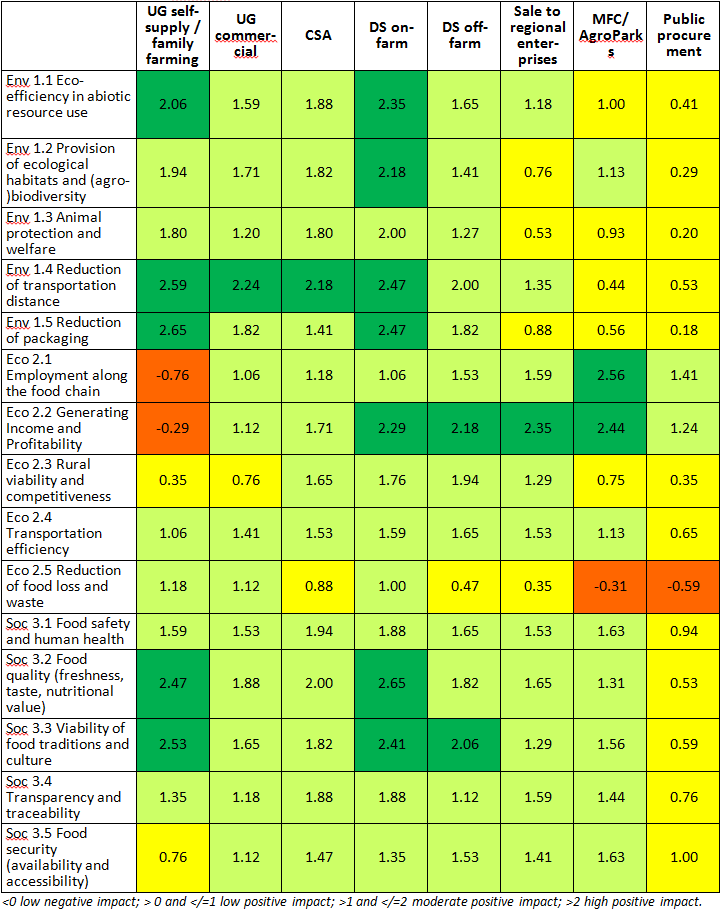Sustainability Impact Assessment Workshop Ljubljana
Background: SIA Preparation and Implementation
In the Slovenian case study all chain types for three different commodity groups: pork meat, fruit and vegetable were assessed regarding their potential sustainability. The research team from Ljubljana organized so far three workshops with four different stakeholder groups:
- Monday 28th April 2014: pork chains with 11 participants from pig sector (enterprises, associations and farmers/producers)
- Wednesday 21st May 2014: vegetable with 17 participants (enterprises, urban gardeners, farmers/producers) and fruit sector with 7 participants (enterprises, associations and farmers/producers)
- Thursday 22nd May 2014: Urban gardeners
The SIA exercise started with an explanation of the research aims and of the terminology / expression used before the participants filled in the table on their own. Subsequently a short discussion of 20 minutes about the topic took place. The evaluation of the chain types was based on existing food chains in the Ljubljana region, only the case of the MFC / AgroParks was hypothetical. In comparison with the other case study regions, the first chain type included not only Urban Gardening for self-supply, but also family farming (subsistence), which is not very common in Berlin or London, but typical for many post-socialist countries and African countries. Below we present only the results for the commodity group ‘vegetable’, the results for the other studied commodity groups (pork and fruit) are part of the Annex VI.
Ranking of food chain types according their overall sustainability performance
According to the Slovenian experts estimations, vegetable food chains with direct consumer-producer-relation (direct sale on-farm, CSA and direct sales off-farm) feature the highest positive sustainability impact. The lowest impacts were expected from MFC/AgroParks and public procurement. Like in the London case study the social and environmental impacts were rated higher than the economic.
Differences between commodity groups
The results of the SIA for the three studied commodity groups (pork meat, fruit and vegetable) indicate only little differences between the chain types for pork chain and larger differences for fruit and vegetable chains. On the other hand the experts for pork gave higher ratings than the other for fruit and vegetable, but this is also the group which has fewer difficulties with the SIA exercise than the other. It is also worth to mention that especially urban / family farming for self-supply has a distinct different sustainability profile than the other chain types for all three commodity groups.
Sustainability profile of the food chain types (strength and weaknesses)
The Slovenian participants of the SIA exercise for vegetable chains estimated predominantly positive impacts, but they rated the impacts more differentiated than the European experts in the online survey and the experts from the London case study. This becomes particular visible for the economic impacts and for the impact field ‘reduction of transportation distance’ which were assessed as ‘very positive’ for more chain types. Negative impacts are related to employment and income in the case of Urban Gardening / family farming for self-supply and to the reduction of food waste and loss for MFC/AgroParks and Public procurement. This leads us to the estimation that especially large scale and long (regional) food chains tend to produce more food waste and loss, on conformity with the in the literature claimed contribution of short chains to the reduction of food waste. If and how this is really the case could be an interesting question for further investigations.
Among the chain types ‘public procurement’ is scored with notable low effects in most of the impact fields. We assume that the recent chain organisation is not favour able to reach a more sustainable mode of urban food provision at the moment. But because of the high relevance of public procurement in the urban food system (demand for food products, amount of prepared food, number and diversity of supplied consumers etc.) the potential impact on sustainability of the food system could be very high.
As strengths of the studied chain types, we can identify the reduction of transportation distance (type a-d), the potential to generate income and profitability (type d-g) and enhancing viability of food traditions and culture (type a, d, e). The highest positive impact (value of 2.65) feature Urban Gardening / family farming for self-supply, because of the potential to reduce packaging (environmental impact) and direct sales on-farm related to food quality (social impact).

